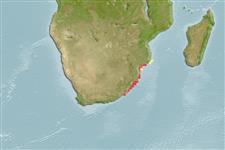Environment: milieu / climate zone / depth range / distribution range
Ecologie
marien rifbewoner; standvastig; diepte 10 - 100 m (Ref. 5222), usually 30 - 80 m (Ref. 89707). Subtropical; 23°S - 35°S, 29°E - 38°E (Ref. 5222)
Western Indian Ocean: Quissico, Mozambique to East London, South Africa.
Grootte / Gewicht / Leeftijd
Maturity: Lm ? range ? - ? cm
Max length : 100.0 cm TL mannelijk / geslacht onbekend; (Ref. 5222); max. gepubliceerd gewicht: 13.0 kg (Ref. 4787)
Dorsale stekels (totaal): 11; Dorsale zachte stralen (totaal): 14; Anale stekels 3; Anale zachte stralen: 8. Distinguished by the following characteristics: head, body, dorsal and caudal fins pale brown, with numerous dark brown spots; ventral parts of head and body lacking spots; juveniles, many of the spots merge to form double spots; prominent dark brown streak along the upper edge of maxillary groove; margin of interspinous dorsal fin membranes yellow or gold; soft dorsal and anal fin dusky distally, with prominent white edge; upper and lower edges of posterior part of caudal fin white edged; pectoral fins yellowish or reddish orange; body depth less than head length, 2.6-3.0 times in SL; head length 2.3-2.5 times in SL; angular preopercle, 2-3 enlarged serrae at the angle; upper edge of operculum straight or convex; naked maxilla, without a step on ventral edge; caudal fin truncate, corners rounded in adults, posterior edge convex in juveniles; lateral body scales ctenoid, with few auxiliary scales in adults (Ref. 089707).
Found over rocks and corals at depths of at least 100 m. Feeds mainly on benthic invertebrates, also on fishes and squids (Ref. 4787, 5213).
Levenscyclus en paargedrag
Maturiteit | Voortplanting | Paaien | Eieren | Fecunditeit | Larven
Heemstra, P.C. and J.E. Randall, 1993. FAO Species Catalogue. Vol. 16. Groupers of the world (family Serranidae, subfamily Epinephelinae). An annotated and illustrated catalogue of the grouper, rockcod, hind, coral grouper and lyretail species known to date. Rome: FAO. FAO Fish. Synop. 125(16):382 p. (Ref. 5222)
Status op de Rode Lijst van het IUCN (Ref. 130435)
Gevaar voor de mens
Harmless
Gebruik door de mens
Visserij: visserij voor eigen gebruik
Meer informatie
Lokale namenSynoniemenMetabolismePredatorenEcotoxicologieVoortplantingMaturiteitPaaienPaaiaggregatiesFecunditeitEierenOntwikkeling van de eieren
ReferentiesAquacultuurAquacultuurprofielKweeklijnenGeneticaElectrophoresesErfelijkheidZiektesVerwerkingNutrientsMassaconversie
Tools
Speciale rapporten
Download XML
Internetbronnen
Estimates based on models
Preferred temperature (Ref.
123201): 21.9 - 25.4, mean 24.5 °C (based on 22 cells).
Fylogenetische diversiteitsindex (Ref.
82804): PD
50 = 0.5000 [Uniqueness, from 0.5 = low to 2.0 = high].
Bayesian length-weight: a=0.01259 (0.00654 - 0.02422), b=3.04 (2.88 - 3.20), in cm total length, based on LWR estimates for this species & Genus-body shape (Ref.
93245).
Trofisch niveau (Ref.
69278): 4.2 ±0.53 se; based on food items.
Weerstandsvermogen (Ref.
120179): laag, minimale populatieverdubbelingstijd 4,5-14 jaar (Preliminary K or Fecundity.).
Fishing Vulnerability (Ref.
59153): High vulnerability (60 of 100).
